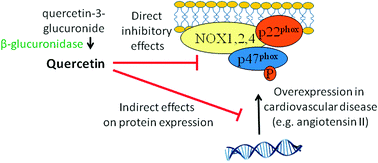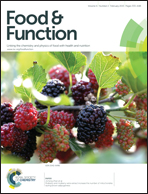Quercetin and its metabolites inhibit the membrane NADPH oxidase activity in vascular smooth muscle cells from normotensive and spontaneously hypertensive rats
Abstract
Quercetin, the most abundant dietary flavonol, exerts antioxidant effects reducing vascular superoxide (O2−) and improving endothelial function in animal models of cardiovascular disease. Herein we evaluated the effects of quercetin, and its plasma metabolites, on the nicotinamide adenine dinucleotide phosphate (NADPH)-oxidase activity, the main source of O2− in the vessel wall, in vascular smooth muscle cells (VSMCs) from spontaneously hypertensive rats (SHR) and normotensive Wistar Kyoto rats (WKY). Quercetin and its metabolites isorhamnetin and kaempferol inhibited the NADPH-stimulated lucigenin-chemiluminescence signal in VSMCs from both strains. The inhibitory effect of quercetin-3-glucuronide increased after prolonged incubation and was inhibited in the presence of the β-glucuronidase inhibitor saccharolactone. These effects were unrelated to their O2− scavenging properties, since they induced only a small inhibition of the rate of pyrogallol autoxidation at high concentrations. All bioflavonoids tested acted as non-competitive inhibitors with respect to NADPH. In conclusion, quercetin and its metabolites inhibit the NADPH oxidase activity in VSMCs reducing O2− generation more efficiently than their effect as O2− scavengers. The effect of quercetin-3-glucuronide was due to deconjugation and release of free quercetin. The effect is similar in VSMCs from normotensive and hypertensive animals.


 Please wait while we load your content...
Please wait while we load your content...